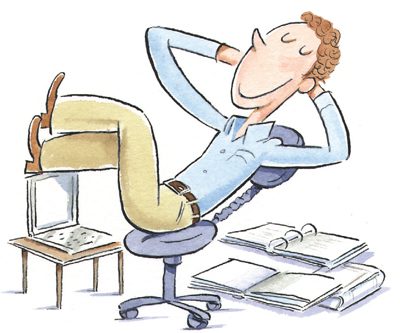By Jeff McClellan
 If you find yourself constantly stressed out, a BYU professor says it may be because you haven’t run from enough saber-toothed tigers lately.
If you find yourself constantly stressed out, a BYU professor says it may be because you haven’t run from enough saber-toothed tigers lately.
“When you perceive stress and you feel fear, your body has some changes,” explains Steven G. Aldana, an assistant professor of physical education. Your blood pressure rises and glucose, adrenaline, and other chemicals are released into your bloodstream.
Back in the early days of the earth, when you were faced with a stressful situation–i.e., a saber-toothed tiger–says Aldana, “you had two options: you could fight the saber-toothed tiger, or you could run from the saber-toothed tiger. Either one of those activities would cause you to exert tremendous amounts of physical movement.” All that physical movement, he explains, would then burn off the chemicals, lower your blood pressure, and your body would return to normal.
Today, however, stressful situations–i.e., deadlines, relationships, life-changing events–don’t demand a fight or flight response, but those chemicals are still released, causing physiological stress. When people aren’t physically active, the stress-related chemicals aren’t burned off.
“We maintain this elevated level of stress, and those blood chemicals are almost always there in some small amount. It’s a constant plateau,” says Aldana. Since our bodies weren’t built to handle such a plateau, the system wears out and we get heart conditions, high blood pressure, and other health problems.
One way to prevent those problems is to exercise 30 minutes a day, says Aldana, who recently published a study of the relationship of physical activity to perceived stress in the journal Perceptual and Motor Skills.
“We really wanted to get down to the core and just look at perceived stress, because that’s really where it starts anyway–how you perceive your environment and what is pushing you or pulling you in certain directions,” Aldana says.
Based on surveys conducted with more than 32,000 working adults, the study not only examined physical activity and perceived stress, but also looked at other possible stress- causing factors, such as personality traits, ongoing problems, life changes, and health status. A statistical study of the surveys was then able to determine the relationship between physical activity and stress, independent of the other factors.
“We found that those two are very well related, and inversely related, so that the more stress you have, the less physically active you’re likely to be, or vice versa. That relationship held through after we statistically controlled for everything else,” Aldana says.
The results showed that individuals who were physically active were about half as likely to have a high level of stress as those who were not physically active. In addition, they had a 30 percent less chance of having a moderate level of stress.
Aldana is quick to point out that the study only established a relationship and does not prove cause and effect; it is possible that stressed people just don’t exercise or that exercise appeals to people who aren’t stressed. However, other research supports the conclusion that physical activity does reduce stress. The cause of the effect is left to speculation at this point, he says, but there are two strong contenders for the explanation.
“Typically, if you are physically active, you’re out there with somebody,” says Aldana. “You’re out there skating with somebody or riding with somebody or playing tennis with somebody or walking and talking with somebody–there’s some kind of social interaction when you’re physically active.”
As you spend time with someone and talk to them and share your problems and challenges, he says, there may be some stress-coping mechanisms that take place.
“The other part of it is there might be some physiological changes,” Aldana explains. “You might not be getting a high level of fitness, but maybe it’s enough to get some physiological changes which will reduce the way your body reacts to stressful situations.”
It’s the old saber-toothed tiger story–tiger causes stress, stress induces chemical release, tiger encourages physical activity, physical activity burns chemicals, body returns to normal (assuming you’re not eaten by the tiger).
Other studies have shown that people who are physically fit are less stressed than those who are not fit, but this study, Aldana says, shows that you may not even need to be physically fit if you are just active. Of those in the study who were physically active, 62 percent said their most common form of activity was walking, an activity that does not generally lead to a high level of physical fitness, he says.
In addition, it doesn’t take much, Aldana says, to be sufficiently active–30 minutes a day of some physical activity will do the job, and activities such as mowing the lawn or mopping the floor can count. Doing something you enjoy, however, is important, but the activity depends on you. “Go for a half hour. Go for a jog, go play tennis, go do something,” he says.
To those who insist they’re too busy to exercise, Aldana counsels, “Take a walk down to your local hospital and sit down in their cardiac rehab center where the people are on treadmills, and look around at those people. Many of them are stressed-out individuals who used the same excuses you use: ‘I don’t have time. I’ve got too much to do. I’m under too much pressure.’
“It will catch up to you. It won’t take long–somewhere between 45 and 60 you’ll have your first bypass or your first angioplasty, and if you’re lucky enough to survive, you’ll be down there with them. You don’t have to be obese, you don’t have to be unfit, you don’t have to have a horrible diet–although all of those things are significant risk factors. You can just be plain stressed out, and it might happen to you.”









